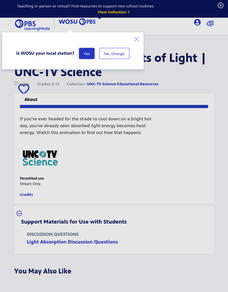TED-Ed
What Is Juneteenth, and Why Is It so Important?
A short TEDEd video details the history of Juneteenth celebrations, the events of June 19, 1865, and the importance of Juneteenth celebrations.
American Museum of Natural History
Ask a Scientist About Microbes
Microbes are the focus of 10 brief videos that showcases microbiologist Susan Perkins, who answers questions about how, what, where, and why.
PBS
Pitch and Frequency | UNC-TV Science
Musicians and physicists unite for an activity that explains frequency using the guitar as an example. Scientists view an animated video defining frequency and explore pitch changes. During the activity, tension changes on guitar strings...
PBS
Categorizing Matter | UNC-TV Science
Take the difficulty out of classifying matter with an easy-to-follow activity that makes distinguishing between pure substances and mixtures simple. Scholars explore how matter is grouped between two categories—pure substances and...
PBS
Cellular Respiration | UNC-TV Science
Find out why Earth hangs in a delicate balance between cellular respiration and photosynthesis with a compact activity. Biologists compare and contrast cellular respiration with photosynthesis by examining the functions and products of...
American Museum of Natural History
Pondlife: Our Tiny Neighbors
Three episodes explore pondlife with microbiologist Sally Warring from the American Museum of Natural History. Videos give scholars an up-close look into the microbes that live among pond scum, algae, and moss while the host offers...
PBS
Volume and Amplitude | UNC-TV Science
Future physicists pump up the volume while discovering the world of sound waves. Group members learn about the qualities of sound waves, the relationship between energy and sound volume, and the definition of amplitude while viewing an...
PBS
Tropism and Dormancy | UNC-TV Science
Since plants can't move to a better environment, they have their own way of dealing with less-than-ideal conditions. A quick animation provides learners with an overview of the strategies plants use to adapt within their environments....
PBS
Protists | UNC-TV Science
Humans are made of trillions of cells while protists are composed of just one. Individuals use the video lesson to examine how these unicellular organisms eat, move, reproduce, and excrete waste with a single cell. The video is short but...
PBS
Solar Eclipse Animation | UNC-TV Science
All locations during a solar eclipse are not equal. Whether in the umbra, penumbra, or outside range, between two and five solar eclipses happen each year. With an engaging video, young scientists learn eclipse vocabulary as well as view...
PBS
Solar Eclipse: Awesome Totality
The next solar eclipse will happen soon, but it's unlikely humans will be able to see it. A video lesson gives a brief overview of the scientific history of the solar eclipse. Pupils learn how Einstein connected a solar eclipse to his...
PBS
Introduction to Waves | UNC-TV Science
Introduce classes to the idea of waves with a short video clip. An interesting presentation gives a quick but thorough overview of the different types of waves and where people encounter them.
PBS
Seismic Waves | UNC-TV Science
No need to wave the white flag. Use an animation to demonstrate the motion of seismic waves instead. A short animation shows the motion of longitudinal and transverse waves. Pupils also learn how the movement displaces the earth.
PBS
A Farewell to Arms: Shaping Fact for Fiction
Clips from the documentary Hemingway by Ken Burns and Lynn Novick reveal how Ernest Hemingway incorporated his own war experiences in A Farewell to Arms. Young writers then take an experience from their own lives and craft it as a work...
PBS
Hemingway’s The Sun Also Rises: “Talking” with Authors and Scholars
Film clips from the documentary Hemingway Ken Burns and Lynn Novick provide readers of The Sun Also Rises with the opportunity to hear what other writers and critics have to say about Hemingway's portrayal of the post-World War I Lost...
PBS
Comparing Hemingway to Young Adult Literature
Challenge groups to create a recommended reading list of contemporary young adult fiction that explores the same themes found in Ernest Hemingway's short stories and novels. After examining a list Hemingway created and a list put...
PBS
Genome 101: Life's Instruction Manual | UNC-TV Science
Crack open the mysteries inside a genome. Participants view an animated video describing the relationship between DNA, genes, proteins, chromosomes, and an organism's genome. A post-video worksheet allows pupils to apply knowledge by...
PBS
Genes 101: Life’s Instruction Manual | UNC-TV Science
Discover the common genetic ground shared by humans and chickens. Group members listen and view an animation about genes and proteins, which details their roles in building biological structures such as tissues and organs. Participants...
PBS
What's the Matter? | UNC-TV Science
Explore what makes up the universe and demystify the complex ideas of matter and the atom. Group members watch a video with explanations, animations, and examples that discuss the characteristics and importance of matter. Scholars then...
PBS
Light Absorption: Effects of Light | UNC-TV Science
Beat the summer heat by exploring the properties of color. Scientists view a video explaining the relationship between light absorption and energy transfer using variables including intensity, time, and wavelength. A multiple-choice...
PBS
Reflection and Refraction | UNC-TV Science
Uncover the exciting interactions of light energy and matter ranging from color to optical illusions. Participants explore color using red and green apples, differences between reflection and refraction, and descriptions of related...
PBS
Atoms and Elements | UNC-TV Science
It doesn't get any smaller than this. Young scientists learn about the particles that make up elements and how they form new substances by creating molecules. The video tutorial includes animations to illustrate atoms and molecules...
PBS
Light Scattering: Effects of Light | UNC-TV Science
A video lesson describes how light absorbs, reflects, and scatters on different surfaces. Pupils learn the result of these different reactions and how humans perceive them.
PBS
Electromagnetic Waves | UNC-TV Science
These waves aren't for surfing. Young scientists learn about electromagnetic waves and how their features affect the light people see. The video lesson describes the amplitude, frequency, and wavelength of the waves and how the...

























